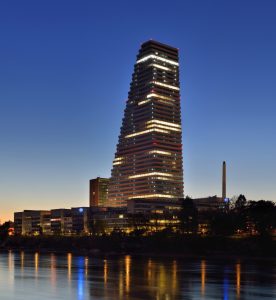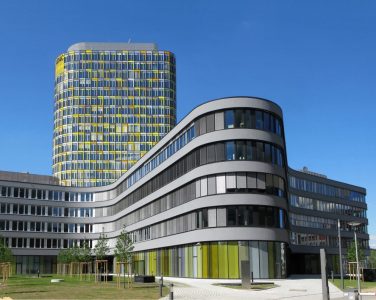Self-powered IoT sensors for building automation
Issue :
read all articles online
read as pdf
The Internet of Things is more than just a buzzword in the construction sector. Smart products from EnOcean help commercial building owners protect their investments and simultaneously offer their tenants as yet undreamt-of flexibility in organizing their space.
Flexibility is the greatest potential that investors can tap for their commercial buildings. The days when a finished building served only one customer and one purpose are long gone. Particularly in large cities, with their fast pace of life, builders must be able to remodel commercial buildings as quickly as possible and with a minimum of effort.
Although this approach is not a new one, the reality is that it comes with a number of problems, especially in terms of cabling. Ceiling lamps and floor tanks for electricity, networks and lights may enable investors and planners to generally change the walls dynamically. However, once classic room thermostats, doorbells, switches or sensors are added, and wired in, changing the layout becomes much harder and more expensive.
A new generation of building automation solutions based on self-powered wireless switches and senors is the answer – retaining flexibility and adaptability and allowing the needs of a succession of occupiers to be addressed fully at minimal expense. They rely on modern wireless protocols for communication and, more importantly, generate the necessary electricity themselves, which means they are not dependent on batteries. As a result, they give investors unprecedented flexibility in outfi tting new commercial buildings. Space whose purpose or use is not yet known can be placed into service with one or two room thermostats and a couple of transmitters and switches for lighting and shading without having to lay any new cables. A tenant can add to these systems almost at will and integrate them into the building control technology.
Smart scenarios, intelligent data analyses
Not only is this practical, it also permits entirely new, smart scenarios. for example, it is possible to mount light switches directly on workstations or place a master switch right at the entrance. In addition, economical sensors enable the room climate to be precisely monitored. All end points can transmit their data to a central system, which evaluates the information and makes decisions according to the requirements. The system is not limited to temperature. with the right sensors, for example, consumption values, air quality or usage frequency can also be detected by the minute and made available to the building operator or tenant.
The best part is that the data itself is not tied to a specific purpose. Tenants or the operator can use the information for their analyses. Investors can do the same to track the value of their property over a long period of time. It is even possible to evaluate the data again at a later point in time, for example when technologies such as the Internet of Things make it possible to develop new business models.
EnOcean and the EnOcean Alliance: Partners to builders and investors
In addition, EnOcean-based products support common home automation standards and products via gateways, including, for example, KNX, BACnet, LON, M-Bus and Modbus.
The great benefit of adopting standardsbased products is that investors not only retain flexibility in constructing the commercial building but also in their selection of the mobile devices. So what if a manufacturer’s design no longer fits the purpose or the product is no longer available? No problem. The EnOcean ecosystem will offer a suitable alternative that is compatible with existing systems.
The fact that existing systems can be converted or upgraded at any time is particularly attractive to building owners. for example, if a new tenant moves in and wants to reorganize the partition walls, the amount of work involved remains minimal. The energy-harvesting wireless devices can be easily moved, placed elsewhere or added and integrated into the central building management system without problems. This approach is also beneficial if a tenant relocates. for example, it allows furniture to be planned without having to take inconvenient switches into account.
Real experience instead of big promises
Self-powered building automation systems using energy harvesting technology based on the EnOcean standard are in use in more than 400,000 buildings throughout the world now rely on products with EnOcean technology. One recent example is “Bau 1” in Basel, Switzerland. The building is a 41-story structure that operates with maximum energy efficiency and flexibility, thanks to Sauter and EnOcean products.

“Bau 1” in Basel sets new standards in terms of energy efficiency and maximal flexibility.
Both the building space and the building management system have a modular design. It takes just a few clicks of the mouse in the management system to convert individual offices, for example, into an open-plan layout. The room operating devices, a Sauter ecoUnit with EnOcean technology, are wireless and operate without batteries. The necessary energy is generated directly at the switch via highly efficient solar modules that work for up to five days even in complete darkness.
This is where flexibility comes to bear: if an office is renovated, all that is needed is to remove the switch units and remount them in the new location. Once the individual products have been moved to their new location in the central building management system and linked to the suitable control systems (for shading or temperature control, for instance), they are ready for use. This saves a great deal of time compared to systems that depend on separate cables for electricity and data transfer.

Another specific example are the ADAC headquarters in Munich. More than a third of the 6,800 ADAC employees work in the new building, whose energy efficiency had to meet special requirements – especially in terms of lighting. general areas are illuminated by so-called downlights, which adapt to ambient conditions such as the time of day and amount of sunlight. Additional LED floor lamps are placed at the workstations to guarantee optimum lighting conditions. To enable the individual areas to change quickly, the electrical installation was standardized and equipped for maximum flexibility. Alliance partner WAGO made this possible: “We equipped nearly all the switches for lighting and shading with the EnOcean wireless standard,” explains Markus Lamers, who is responsible for building systems and building automation at ADAC. “We wanted to use an open system rather than a proprietary one.” The company has accomplished this goal. More than 40,000 data points supply the information to the building control system, and more than 900 WAGO controllers are in use. Lamers praises the building’s flexibility: “The great advantage is (…) that a suitable interface card is available for each task.”

Thanks to EnOcean technology, the energy-efficient lighting of the ADAC headquarters in Munich ideally adapts to workplace requirements.
Time savings, flexibility, future viability
Studies have shown that decoupling the inner walls and electrical system alone provides significant time savings during a renovation. These time savings mean more income and fewer limitations. These factors can be expanded even further with EnOcean. Thermostats, sensors and other end points can be flexibly removed and relocated, larger systems can be stored away in the ceilings and then reused over and over again. The actual intelligence lies in the building control system and, once installed, needs to be removed only when maintenance or an upgrade is needed. When tenants change their floor plans, this can be done in the system with a minimum amount of effort, and the building systems can be adapted accordingly.
The EnOcean products impressively demonstrate how the often-quoted buzzword, “the Internet of Things,” can be implemented in concrete terms. Owners of commercial buildings can thus give their tenants a flexibility that would have been unthinkable just a few years ago – and thus protect their own investments for years and decades to come.
New articles in Smart Spaces
Top articles





